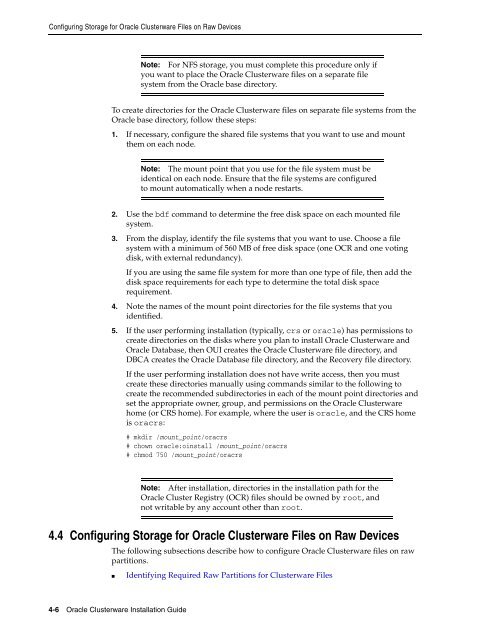Oracle Database Oracle Clusterware Installation Guide for HP-UX
Oracle Database Oracle Clusterware Installation Guide for HP-UX
Oracle Database Oracle Clusterware Installation Guide for HP-UX
Create successful ePaper yourself
Turn your PDF publications into a flip-book with our unique Google optimized e-Paper software.
Configuring Storage <strong>for</strong> <strong>Oracle</strong> <strong>Clusterware</strong> Files on Raw Devices<br />
To create directories <strong>for</strong> the <strong>Oracle</strong> <strong>Clusterware</strong> files on separate file systems from the<br />
<strong>Oracle</strong> base directory, follow these steps:<br />
1. If necessary, configure the shared file systems that you want to use and mount<br />
them on each node.<br />
2. Use the bdf command to determine the free disk space on each mounted file<br />
system.<br />
3. From the display, identify the file systems that you want to use. Choose a file<br />
system with a minimum of 560 MB of free disk space (one OCR and one voting<br />
disk, with external redundancy).<br />
If you are using the same file system <strong>for</strong> more than one type of file, then add the<br />
disk space requirements <strong>for</strong> each type to determine the total disk space<br />
requirement.<br />
4. Note the names of the mount point directories <strong>for</strong> the file systems that you<br />
identified.<br />
5. If the user per<strong>for</strong>ming installation (typically, crs or oracle) has permissions to<br />
create directories on the disks where you plan to install <strong>Oracle</strong> <strong>Clusterware</strong> and<br />
<strong>Oracle</strong> <strong>Database</strong>, then OUI creates the <strong>Oracle</strong> <strong>Clusterware</strong> file directory, and<br />
DBCA creates the <strong>Oracle</strong> <strong>Database</strong> file directory, and the Recovery file directory.<br />
If the user per<strong>for</strong>ming installation does not have write access, then you must<br />
create these directories manually using commands similar to the following to<br />
create the recommended subdirectories in each of the mount point directories and<br />
set the appropriate owner, group, and permissions on the <strong>Oracle</strong> <strong>Clusterware</strong><br />
home (or CRS home). For example, where the user is oracle, and the CRS home<br />
is oracrs:<br />
4-6 <strong>Oracle</strong> <strong>Clusterware</strong> <strong>Installation</strong> <strong>Guide</strong><br />
Note: For NFS storage, you must complete this procedure only if<br />
you want to place the <strong>Oracle</strong> <strong>Clusterware</strong> files on a separate file<br />
system from the <strong>Oracle</strong> base directory.<br />
Note: The mount point that you use <strong>for</strong> the file system must be<br />
identical on each node. Ensure that the file systems are configured<br />
to mount automatically when a node restarts.<br />
# mkdir /mount_point/oracrs<br />
# chown oracle:oinstall /mount_point/oracrs<br />
# chmod 750 /mount_point/oracrs<br />
Note: After installation, directories in the installation path <strong>for</strong> the<br />
<strong>Oracle</strong> Cluster Registry (OCR) files should be owned by root, and<br />
not writable by any account other than root.<br />
4.4 Configuring Storage <strong>for</strong> <strong>Oracle</strong> <strong>Clusterware</strong> Files on Raw Devices<br />
The following subsections describe how to configure <strong>Oracle</strong> <strong>Clusterware</strong> files on raw<br />
partitions.<br />
■ Identifying Required Raw Partitions <strong>for</strong> <strong>Clusterware</strong> Files
















